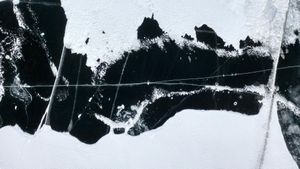The recent Kahramanmaraş earthquakes, with magnitudes of 7.8 and 7.6, have unveiled extensive off-fault damage surrounding their surface ruptures, raising significant questions about the accuracy of fault slip measurements.
On February 6, 2023, Türkiye was rocked by two monumental earthquakes, sending shockwaves felt across the region and affecting the geological assessments of seismic hazards. New research utilizing satellite synthetic aperture radar (SAR) images has quantified the off-fault damage associated with these events, and results suggest approximately 35% of coseismic slip is absorbed by deformation several kilometers from the fault line.
Scientists employed advanced SAR techniques to derive three-dimensional coseismic surface displacements, demonstrating how off-fault damage—predominantly near geometrically complex fault areas—differentially impacts the slip estimates traditionally used to assess seismic hazards. Data reveals this off-fault damage zone averages around 5 km wide, significantly more extensive compared to previous studies.
The study found fault sections exhibiting geometrical complications, such as bends and step-overs, sustained higher levels of off-fault damage than more linear counterparts. This complexity adds layers of challenge to determining precise fault slip rates, with potential underestimations of as much as one-third, as highlighted by the researchers.
Dr. J. Liu, one of the authors, stated, "Fault sections exhibiting geometrical complexitites experienced a higher level of off-fault damage than simpler fault sections." These findings serve as a call for the scientific community to reevaluate existing models of seismic slip which have historically regarded the surface ruptures as the primary indicators of seismic activity.
Prior studies focused predominantly on near-fault deformation, often neglecting the significant influences of off-fault damage. Liu emphasized the broader impacts, noting, "Our results highlight the importance of extending off-fault damage assessments to several km away from fault ruptures." The research suggests traditional slip-rate measurements taken along fault traces may fail to reflect the true seismic dynamics at play.
Quantifying such off-fault damage is pivotal, especially considering the relationship between slip propagation and fault complexity. Current models fail to incorporate the full extent of elastic and plastic deformation mechanisms, highlighting the absence surface displacement phenomenon linked to off-fault damage zones.
These results have far-reaching consequences for future earthquake hazard assessments, as the observed absent surface displacement (ASD) indicates substantial residual deformation resulting from complex slip dynamics at depth. The study confirms, as Liu remarked, "This fraction is lower on fault sections free of geometrical complexity," making the need for more nuanced and comprehensive assessment methods clear.
Given the growing impacts of urbanization and population density along fault lines globally, researchers advocate for improved methodologies to integrate off-fault damage data alongside traditional seismic models. With significant historical earthquake events recorded along the East Anatolian Fault, the 2023 Kahramanmaraş earthquakes provide invaluable insights for enhancing predictive models.
Overall, using detailed satellite imagery and advanced geophysical techniques, this research aims to redefine our earthquake preparedness strategies and response protocols. Some advocates believe it marks the beginning of new protocols for assessing risk factors along fault lines, integrating learnings from these major seismic events. Groundbreaking seismic predictions hinge on our ability to adapt methodologies based on the latest scientific findings, ensuring communities are shielded from the next tectonic upheaval.
While the delay between significant earthquakes can allow for research and modeling improvements, the time to act is now. The integration of findings from the Kahramanmaraş earthquakes can play a pivotal role as experts aspire to refine the accuracy of forecasts and minimize the impact of future seismic activity.



